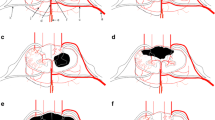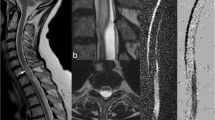Abstract
Introduction
Spinal cord infarction is a rare clinical diagnosis characterized by a sudden onset of paralysis, bowel and bladder dysfunction, and loss of pain and temperature perception, with preservation of proprioception and vibration sense. Magnetic resonance imaging (MRI) usually demonstrates intramedullary hyperintensity on T2-weighted MR images with cord enlargement. However, in approximately 45% of patients, MR shows no abnormality. Diffusion-weighted MR imaging (DWI) has been widely used for the evaluation of a variety of brain disorders, especially for acute stroke. Preliminary data suggest that DWI has the potential to be useful in the early detection of spinal infarction.
Methods
We performed DWI, using navigated, interleaved, multishot echo planar imaging (IEPI), in a series of six patients with a clinical suspicion of acute spinal cord ischemia.
Results
In all patients, high signal was observed on isotropic DWI images with low ADC values (0.23 and 0.86×10−3 cm2/s), indicative of restricted diffusion.
Conclusion
We analyzed the imaging findings from conventional MR sequences and diffusion-weighted MR sequences in six patients with spinal cord infarction, compared the findings with those in published series, and discuss the value of DWI in spinal cord ischemia based on current experience. Although the number of patients with described DWI findings totals only 23, the results of previously published studies and those of our study suggest that DWI has the potential to be a useful and feasible technique for the detection of spinal infarction.


Similar content being viewed by others
References
Nadeltchev K, Loher TJ, Stepper F, et al (2004) Long-term outcome of acute spinal cord ischemia syndrome. Stroke 35:560–565
Masson C, Pruvo JP, Meder JF, et al (2004) Spinal cord infarction: clinical and magnetic resonance imaging findings and short term outcome. J Neurol Neurosurg Psychiatry 75:1431–1435
Yuh W, Marsh EE, Wang AK, et al (1992) MR imaging of spinal cord and vertebral body infarction. AJNR Am J Neuroradiol 13:145–154
Iseli E, Cavigelli A, Dietz V, Curt A (1999) Prognosis and recovery in ischemic and traumatic spinal cord injury: clinical and electrophysiological evaluation. J Neurol Neurosurg Psychiatry 67:567–571
Weidauer S, Nichtweiss M, Lanfermann H, Zanella FE (2002) Spinal cord infarction: MR imaging and clinical features in 16 cases. Neuroradiology 44:851–857
Hundsberger T, Thömke F, Hopf HC, Fitzek C (1998) Symmetrical infarction of the cervical spinal cord due to spontaneous bilateral vertebral artery dissection. Stroke 29:1742
Le Bihan D (1991) Molecular diffusion nuclear magnetic resonance imaging. Magn Reson Q 7:1–30
Bammer R (2003) Basic principles of diffusion-weighted imaging. Eur J Radiol 45:169–184
Lansberg MG, Mangin JF, Poupon C, et al (2000) Comparison of diffusion-weighted MRI and CT in acute stroke. Neurology 54:1557–1561
Burdette J, Ricci PE, Petitti N, Elster AD (1998) Cerebral infarction: time course of signal intensity changes on diffusion-weighted MR images. AJR Am J Roentgenol 171:791–795
Christensen P, Gideon P, Thomsen C, Stubgaard M, Henriksen O, Larsson HBW (1993) Increased water self-diffusion in chronic plaques and in apparently normal white matter in patients with multiple sclerosis. Acta Neurol Scand 87:195–197
Nakahara M, Ericsson K, Bellander BM (2001) Diffusion-weighted MR and apparent diffusion coefficient in the evaluation of severe brain injury. Acta Radiol 42:365–369
Sundgren PC, Reinstrup P, Romner B, Holtas S, Maly P (2002) Value of conventional, and diffusion- and perfusion weighted MRI in the management of patients with unclear cerebral pathology, admitted to the intensive care unit. Neuroradiology 44:674–680
Stadnik TW, Chaskis C, Michotte A, et al (2001) Diffusion-weighted MR-Imaging of intracerebral masses: comparison with conventional MR-imaging and histologic findings. AJNR Am J Neuroradiol 22:969–976
Thurnher M, Castillo M (2005) Imaging in acute stroke. Eur Radiol 15:408–415
Barker GJ (2001) Diffusion-weighted imaging of the spinal cord and optic nerve. J Neurol Sci 186 [Suppl 1]:S45–S49
Schwartz ED, Chin CL, Takahashi M, Hwang SN, Hackney DB (2002) Diffusion-weighted imaging of the spinal cord. Neuroimaging Clin N Am 12:125–146
Holder CA, Muthupillai R, Mukundan S, Eastwood J, Hudgins PA (2000) Diffusion-weighted MR imaging of the normal human spinal cord in vivo. AJNR Am J Neuroradiol 21:1799–1806
Bammer R, Augustin M, Prokesch R, et al (2002) Diffusion-weighted imaging of the spinal cord: interleaved echo-planar imaging is superior to fast spin-echo. J Magn Reson Med 15:364–373
Bammer R, Fazekas F (2003) Diffusion imaging of the human spinal cord and the vertebral column. Top Magn Reson Imaging 14:461–476
Nagayoshi K, Kimura S, Ochi M, et al (2000) Diffusion-weighted echo planar imaging of the normal human cervical spinal cord. J Comput Assist Tomogr 24:482–485
Gass A, Back T, Behrens S, Maras A (2000) MRI of spinal cord infarction. Neurology 54:2195
Stepper F, Lovblad KO (2001) Anterior spinal artery stroke demonstrated by echo-planar DWI. Eur Radiol 11:2607–2610
Weidauer S, Dettmann E, Krakow K, Lanfermann H (2002) Darstellung von zwei Fällen und Literaturübersicht. Nervenarzt 73:999–1003
Sagiuchi T, Iida H, Tachibana S, Kusumi M, Kan S, Fujii K (2003) Case report: diffusion-weighted MRI in anterior spinal artery stroke of the cervical spinal cord. J Comput Assist Tomogr 27:410–414
Fujikawa A, Tsuchiya K, Takeuchi S, Hachiya J (2004) Diffusion-weighted MR imaging in acute spinal cord ischemia. Eur Radiol 14:2076–2078
Fujikawa A, Tsuchiya K, Koppera P, Aoki C, Hachiya J (2003) Spinal cord infarction demonstrated on diffusion-weighted MR imaging with a single-shot fast spin-echo sequence. J Comput Assist Tomogr 27:415–419
Zhang J, Huan Y, Qian Y, Sun L, Ge Y (2005) Multishot diffusion-weighted imaging features in spinal cord infarction. J Spinal Disord Tech 18:277–282
Küker W, Weller M, Klose U, Krapf H, Dichgans J, Nägele T (2004) Diffusion-weighted MRI of spinal cord infarction—high resolution imaging and time course of diffusion abnormality. J Neurol 251:818–824
Loher TJ, Bassetti CL, Lövblad KO, et al (2003) Diffusion-weighted MRI in acute spinal cord ischemia. Neuroradiology 45:557–561
Zhang Z, Nonaka H, Nagayama T, et al (2001) Circulatory disturbance of rat spinal cord induced by occluding of the dorsal spinal vein. Acta Neuropathol 102:335–338
Ahlhelm F, Schneider G, Backens M, Reith W, Hagen T (2002) Time course of the apparent coefficient after cerebral infarction. Eur Radiol 12:2322–2329
Copen WA, Schwamm LH, Gonzalez RG, et al (2001) Ischemic stroke: effects of etiology and patient age on the time course of the core apparent diffusion coefficient. Radiology 221(1):27–34
Pipe JG, Farthing VG, Forbes KP (2002) Multishot diffusion-weighted FSE using PROPELLER MRI. Magn Reson Med 47:42–52
Conflict of interest statement
We declare that we have no conflict of interest.
Author information
Authors and Affiliations
Corresponding author
Rights and permissions
About this article
Cite this article
Thurnher, M.M., Bammer, R. Diffusion-weighted MR imaging (DWI) in spinal cord ischemia. Neuroradiology 48, 795–801 (2006). https://doi.org/10.1007/s00234-006-0130-z
Received:
Accepted:
Published:
Issue Date:
DOI: https://doi.org/10.1007/s00234-006-0130-z




